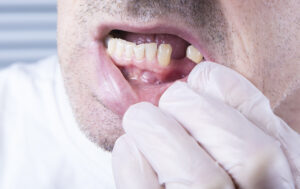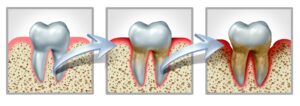Header logo
header top contact widget
Financing Options
AI in Dentistry – A Good Thing.
Posted on Jul 05, 2023 by William J. Claiborne, DDS MS
I remember when microwave ovens first appeared on the market. My mom wouldn’t even go near one in operation. Now, we know how to use them and the good things that come from their use.
Shoot forward 50 years and, like it or not, AI (artificial intelligence) is here. Self driving cars and round vacuums that move along floors are no longer Jetson-like imaginings. They’re blending into our lives in ways that are beneficial and non-threatening.
Like the microwave oven easing its way into day-to-day living, it’s logical that some people fear AI as a bad thing. After all, movies made decades ago prompted a vision of robots meandering among the human race as a new, threatening species.
As an Asheville periodontist, I’ve already seen – and incorporated in use – the positive aspects of breakthrough technology. Understanding its detection capabilities and accuracy, I’m particularly excited about the potential AI brings to the medical and dental fields.
You may be surprised to know that dentists are already beginning to turn to AI technology to quickly and accurately detect and prevent periodontitis, decay, bone loss and other gum health issues.
For example, a medical technology company in Boston has developed an AI platform that can assess X-ray images to an extent of over 50 times what can be detected by dentists through visual reviews. This allows dentists to give more effective treatment recommendations for patients while supporting the potential to avoid (or minimize) existing problems from developing or worsening.
For patients, AI assessments can also be reassuring. For those who anticipate particular treatment needs – a root canal, for instance – these assessments can zero in on exact issues so treatment planning is as conservative and as minimal possible, while being fully effective for the particular need.
Not just in medical and dental offices, but we’ll likely see AI used mainstream in many sectors. It can optimize accuracy in organizational materials, financial and budget projections, construction, farming, etc. For those of us in the periodontal dental field, AI has a vast potential to greatly improve the oral – and overall – health of our population.
Gum disease affects over 47% of American adults. With the help of AI, we can identify a higher percentage of cavities in earliest development stages while cutting the rate of misdiagnosis in half (thus curtailing over-treatment, in some cases). AI analysis will also aid in early detection of abscesses, lesions and oral diseases. It can prove to be a remarkable asset in catching oral cancer, helping to increase its poor survival rate or minimize the severity of treatment.
Through decades of research and extensive studies, keeping good oral health has been shown to be a supporting factor in good overall health. By keeping the “bad” bacteria in the mouth to manageable levels, the immune system operates more efficiently. Too, risk of medical complications from diabetes, heart disease and other illnesses can be significantly decreased.
It is suspected that many people are unaware that they even have periodontal (gum) disease, mainly because gum disease often begins with no obvious symptoms of its presence. Then, once symptoms appear (such as seeing blood in the sink when brushing), people may shrug this off as normal, or merely a sign they are being thorough in their brushing technique.
Gum disease is a particular problem for our aging population. The normal aging process dries out our hair, skin, and yes, the mouth. When the mouth is dry and saliva flow is insufficient, bacteria accumulation is more likely. This, in turn, provides a more welcoming environment for bacteria growth.
Too, many medications on the market – both prescription and OTC – have a side effect or oral dryness. This is double trouble for seniors, who already have “dry mouth” to combat. However, for people who smoke and/or are consumers of caffeine, they fall into this risk group as well.
Caffeine is present in coffee, tea, most colas, and (darn!) even chocolate. It can be in high concentrations in things like energy drinks and “power” bars. Caffeine-fortified foods can surprisingly include marshmallows, some cereals (and breakfast bars), jelly beans, gummy bears and frozen waffles.
Although AI will be an added perk to diagnosing oral health problems, it is the dentist and the patient together who have much more important roles. While regular dental check-ups help to remove existing buildup on teeth (known as plaque, which can harden into tartar), at-home care is what helps to prevent problems between visits.
It is first important to know the signs and symptoms of the various stages of gum disease. Warning signs include:
• Red, swollen, or tender gums or other pain in your mouth
• Bleeding while brushing, flossing, or eating hard food
• Gums that recede or pull away from the base of teeth
• Loose or separating teeth
• Pockets of pus between gums and teeth
• Sores in the mouth
• Persistent bad breath
• A change in the way your teeth fit together when you bite
• A change in the fit of partial dentures
The dentist-patient relationship can never be replaced by AI. Once you find a dental office where you feel respected, comfortable, and have total confidence, technology itself is merely an add-on.
If you have not had regular dental care or feel you have symptoms of gum disease (as listed above), it is recommended that you renew your commitment to your smile and your overall health with a complete periodontal dental examination.
During this time, your periodontist will note any areas that are diseased or at risk of developing such. He or she will explain recommended treatment and discuss a comfortable pace for your individual needs. Payment plans can also be discussed after determining the type of treatment most appropriate for your care.
If dental fear or anxiety has kept you from regular dental care, our NW Carolina periodontal dental office has a reputation for helping adults overcome the obstacles it can pose. Please share your concerns prior to or during your examination appointment. We offer several comfort options (in addition to our reputation for a gentle touch) and can explain what may be best for your care. We offer oral and IV sedation (twilight sleep), which are administered safely and with advanced monitoring equipment.
Too, our vast array of advanced technology often helps to minimize treatment while optimizing comfort. Please learn more about these features at: BiltmorePerio-Technology
We can’t stop progress, nor should we resist it. While most anything can be used with ill-will, I see AI in dentistry as a positive part of providing exceptional oral health to our patients – and our adult population!
But first, we must get you into the office. And that’s your decision. We don’t have technology to coax you in and hope you will take that step on your own before problems force you into a dental chair (which is often the case, unfortunately).
Call 828-274-9440 for an appointment or to have your initial questions answered.
Sources:
https://www.perio.org/for-patients/gum-disease-information/
3 Things You’re Doing To Up Your Risk for Gum Disease
Posted on May 15, 2023 by William J. Claiborne, DDS MS
In life, we don’t know what we don’t know. As a periodontal specialist in Western NC, I see this a lot with adults who develop periodontal (gum) disease. Many go most of their lives unaware that certain things they’ve been doing all their lives led (or can lead) to the development of gum disease and often, tooth loss as a result.
According to a report on the health of Americans (published by the CDC, the Centers for Disease Control & Prevention), it is estimated that over 47% have some form of gum disease. Although we all aspire to have a smile that is appealing, it is what lies beneath the teeth and gums that can wreak havoc on one’s overall health.
Over time, inadequate daily oral hygiene enables an overload of bacteria in the mouth. Oral bacteria are living, eating, and reproducing organisms, thriving on rotting food particles caught between teeth. They attack gum tissues and tooth enamel and eventually work down tooth roots and attack the bones and tendons that support teeth.
Early signs of gum disease are frequent bad breath along with swollen, tender and beefy red gums that bleed when you brush. As they grow in number, the gum tissues become weaker and they can penetrate the bloodstream.
Through tears in diseased gum tissues, this infectious bacteria can enter the bloodstream. This potent bacteria are now associated with a number of serious health conditions due to their ability to trigger systemic inflammation. These include heart disease, stroke, some cancers, Alzheimer’s disease and more.
According to the American Academy of Periodontology (www.perio.org),
“Several studies have shown that periodontal disease is associated with heart disease. While a cause-and-effect relationship has not yet been proven, research has indicated that periodontal disease increases the risk of heart disease.
“Scientists believe that inflammation caused by periodontal disease may be responsible for the association.
“Periodontal disease can also exacerbate existing heart conditions. Patients at risk for infective endocarditis may require antibiotics prior to dental procedures. Your periodontist and cardiologist will be able to determine if your heart condition requires use of antibiotics prior to dental procedures.”
Obviously, the goal is to prevent the onset of gum disease. This can be done easily with the investment of just minutes per day and regular dental check-ups and cleanings. The following can give you a good idea as to what you may be doing to make you vulnerable and how to lessen your risks.
• FREQUENT SNACKING
Snacking has become pretty common over the years. Many Americans snack, with such things as a mid-morning latte or afternoon candy bar topped off by a bowl of ice-cream after dinner. All these add-in’s to three meals a day lead up to a bombardment of oral acids in the mouth.
Anytime you eat or drink, an acid attack begins in the mouth. This is a normal part of the digestive system, starting the break-down of foods during the chewing process. However, this also means that every sip of cola or bite of granola bar, an acidic bombardment occurs in the mouth for about 20-30 minutes. When the mouth endures frequent acid attacks during the day, damage to precious tooth enamel will lead to cavities.
Although Americans are the leading nation for sugar consumption, carbs also break down as sugar in the mouth. This means that the potato chips and popcorn you munch on are adding to these risks as well.
• ORAL DRYNESS
Xerostomia, commonly known as “dry mouth,” is a frequent state of oral dryness. Saliva is your mouth’s natural rinsing agent that helps cleanse oral bacteria from the mouth. This keeps bacteria to a minimum.
When saliva flow is depleted, bacteria linger in the mouth longer, giving them more time to multiply. As oral bacteria thrive, reproduce and amass, the initial result is plaque. Plaque is the sticky film you can feel on teeth.
Periodic dry mouth can occur from consuming alcoholic beverages, coffee and certain medications. Although sugary drinks don’t necessarily dry oral tissues (unless they contain caffeine), sugar enhances growth of bacteria reproduction. When food and beverages contain caffeine AND sugar, this hits the mouth with an even higher risk for oral bacteria growth.
Other causes of dry mouth include medications, such as antihistamines and some prescribed for depression and urinary incontinence. Medical conditions, including acid reflux, sinus infections, diabetes and bronchitis are also contributors. A bad cold, snoring or just being in the habit of breathing through the mouth are drying as well. And – the worst culprit of all – is smoking.
• INADEQUATE ORAL HYGIENE AT HOME
Bacteria are living organisms that eat, reproduce and emit waste. Their ability to reproduce is astounding, resulting in a consistently growing number of waste-producing creatures. And they stink, causing bad breath.
Poor oral hygiene is the most common cause for bad breath. Not brushing and flossing or doing so adequately allows oral bacteria to reproduce, which leads to plaque.
When plaque is not removed thoroughly on a daily basis, it turns into a cement-hard substance known as tartar. This mass is actually a solid colony of oral bacteria that attaches to teeth. Once in the form of tartar, it can no longer be brushed or flossed away.
Tartar attacks enamel and gum tissues, causing the gum tissues to become inflamed. This inflammation can quickly develop into gingivitis, an early form of gum disease. If not resolved fully, however, gingivitis can lead to full-blown periodontal disease.
It is estimated that nearly a third of American adults brush their teeth for an insufficient amount of time. Even worse, about that same amount fail to brush twice a day. This means that an alarming amount of bacteria remain to grow and thrive in the mouth.
Proper brushing includes brushing for at least two minutes twice daily with thorough swishing afterwards. Brush using a circular motion rather than scrubbing teeth back and forth (which can damage and wear away tender gum tissues). Never use a hard bristle tooth brush or brush with harsh substances (such as baking soda).
You may be surprised to learn that brushing only tackles about half the amount of oral bacteria. The tongue actually harbors 58 – 65 percent of the bacteria in the “oral cavity.”
Oral bacteria, which take up residence in the tiny bumps and grooves of the tongue, are not easily dislodged. Thus, it is necessary for tongue cleaning to be a part of your oral hygiene regimen at home.
Some toothbrushes have a “tongue scraper” on the reverse side of the bristles that’s an effective option. Or, you can brush your tongue with the bristles after your teeth are brushed. Be sure to reach towards the back of the tongue where the majority of bacteria exist.
If you are experiencing symptoms of gum disease or have not received regular dental care, call 828-274-9440. We’ll arrange a periodontal exam in our comfortable Asheville periodontal office. Or, you can request a consultation appointment to begin. This time will allow you to get to know us and our advanced technology, often saving our patients treatment time while enhancing comfort.
If financial constraints are a concern, ask about our easy payment plans. These can break treatment fees into monthly payments that are manageable to most budgets.
Older Adults (80’s, 90’s, 100’s) Benefit By Dental Implants
Posted on Apr 25, 2023 by William J. Claiborne, DDS MS
Someone once told me, “Old age is always ten years older than the age you are at the time.” I get it. While a teenager may think of anyone over the age of 55 as “old,” aging in the U.S. today has taken a positive position within America’s population.
Proof of this is in how more and more people are living to be 100. Many of them are still sharp and spry. Although reaching the 100 age pinnacle was once a rare feat, it’s a growing trend. Today, there are nearly twice as many 100+ year olds in the U.S. than there were 20 years ago (nearly 90,000 now).
Reaching these elevated ages, of course, depends on factors like location, gender, lifestyle and genetics. Living a long life has evolved from lifestyle changes rather different than what was taken for granted in the 1950’s, for example.
Between 1900 and 2020, life expectancy in the U.S. rose by more than 30 years. Much of this can be credited to life choices, such as things like not smoking. Smoking, a leading contributor to heart disease, can decrease life expectancy by 10 years.
In 1965, 45% of Americans smoked. Now, knowing the health hazards to smoking, the number has declined to only 12.5% as of 2020.
Of course, Americans can also credit medical advances for the centenarian growth in population. The survivability of things like heart attacks and cancer has greatly increased, giving adults a longer lifespan.
As Americans realize their lifespan may well reach age 90, 100 or beyond, the resistance to having dental implants due to “old age” is becoming less of a factor.
Dental implants are the ideal tooth replacement system. Unlike dentures or ‘partials,’ dental implants are supported by the jaw bone, just as natural teeth. While dentures sit on top of the gums, dental implants restore biting strength and stability, giving back the look, feel and function of the teeth you once had.
Two decades ago, some “older” adults would deny themselves the benefits of dental implants, saying things like, “I’m too old to spend that amount of money on myself.” Yet, for my dental implant patients in their 80’s and 90’s, I never had one who didn’t feel it was one of the wisest investments they’d ever made.
Here’s why…
– Dental implants are designed to last your lifetime. They do not decay, need root canals or compromise neighboring teeth or bone structure.
– Because dental implants are positioned in the jaw, they recreate stimulation to the bone. This helps to preserve the bone’s mass, halting the pace of jaw bone shrinkage (known as resorption).
– Resorption is what causes changes in one’s facial appearance, aging one’s appearance far older than their actual age.
– Dental implants do not move or slip when eating, speaking or laughing. A denture is designed to fit the contours of one’s gum ridge; contours that exist at the time the denture is made. However, as resorption reduces bone height, the ridge that holds the denture flattens out over time. This is why a denture becomes ‘wobbly’ or ‘slippery.’
– Dental implant treatment is largely determined by the number of implants placed. In most cases, one implant can support more than one tooth. A full arch (all upper or lower) of teeth are typically supported by several strategically-placed implants.
– Unlike a crown-&-bridge, dental implants so not need the support of adjacent teeth. Therefore, it is not necessary to have teeth shaved down for crowning simply to serve as supports for a bridge.
When it comes to dental implants, there are many decisions and choices that can become confusing without the guidance of a dental specialist. For example, there are over 40 different implant systems.
Dental Implants are designed in a variety of shapes and sizes to accommodate various needs. For those who are missing all upper or lower teeth, for instance, some implant types can support a full arch of removable teeth while others support non-removable (or ‘fixed’) teeth.
As a periodontist for over 3 decades, our patients receive advanced skills in dental implant diagnosis and placement. Additionally, our Asheville periodontal dental office features some of the most advanced technology in the industry today. This includes computerized imaging that can lessen treatment needs, optimize comfort and speed healing.
If you feel you are too old to make this wise investment, check out some of the health benefits that dental implants provide:
• As the ‘arch’ (or ridge) flattens, the appliance is more apt to move while chewing. As the denture rubs against tender gum tissues when eating, sore spots form, which are difficult and slow to heal. And, when small seeds or nut particles become trapped between the appliance and gums, it can cause a piercing, painful sensation.
This discomfort and concern often prompts people to adjust their diets. The chewy, crunchy foods they once enjoyed tend to be bypassed for those that dissolve quickly with minimal chewing required. Unfortunately, these foods are typically lacking in the fiber, vitamins and protein necessary for a healthy diet.
• The gum-colored base of dentures or partials that hold the replacement teeth is made of a porous material. This means there are tiny holes in the base. In the mouth, a denture sits in a warm, dark, moist environment – perfect for bacterial growth. These holes become living spaces to oral bacteria, which thrive and breed at a rapid rate. Bad breath and increased risk of pneumonia are actually some of the lesser problems that can occur.
Additionally, oral bacteria can create havoc throughout the body. It is a known contributor to a long list of serious health diseases and conditions. These include some cancers, stroke, heart disease, diabetes, arthritis, Alzheimer’s disease, pre-term babies and many more.
• The insecurity of a denture that may move when eating causes some people to avoid social gatherings. The fear of embarrassment can be a deterrent to involvement with friends and family. This places the individual at a disadvantage, as research shows that socially active seniors age more slowly than those who avoid social interactions.
If dental fear has prevented you from looking further into dental implants, please know that we have a reputation for respect, a gentle touch, and compassionate care. Additionally, we offer Oral sedation as well as I.V. sedation (also known as ‘twilight sleep’). These are administered safely by a doctor of anesthesia who monitors patients with advanced safety equipment.
Also, financing can be easy through monthly payment plans. Most are interest-free with no down payment required.
To schedule a consultation appointment, call 828-274-9440. Also, get to know more about dental implants at: DrClaiborneDentalImplants
Sources:
https://www.sciencedaily.com/releases/2014/10/141007144514.htm
https://greatergood.berkeley.edu/article/item/how_social_connections_keep_seniors_healthy
Some Internet Dental DIY Advice Can Result In Tooth Loss
Posted on Jan 30, 2023 by William J. Claiborne, DDS MS
With the internet and emergence of social media, there has been an explosion of information and “advice” now at our fingertips. Want to know how to remove a red wine stain, check the internet. Need recommendations on the most scenic route to a vacation cabin, google it.
 Some of the pointers online are helpful. I was finally able to reprogram my garage door opener with help found on it. However, as a periodontal dental specialist in Asheville NC, I’ve been jolted by some of the dental “advice” I’ve come across. It has not been unusual for some of this info to result in patients who come to us with problems that were actually made WORSE!
Some of the pointers online are helpful. I was finally able to reprogram my garage door opener with help found on it. However, as a periodontal dental specialist in Asheville NC, I’ve been jolted by some of the dental “advice” I’ve come across. It has not been unusual for some of this info to result in patients who come to us with problems that were actually made WORSE!
From a dental standpoint, the most common I’ve seen over recent years are…
• Using ‘super glue’ to repair teeth:
Most of these chemical-laden glues are toxic. They are not intended to be ingested in any way in the human body. These toxins can seep into oral tissues, causing irritation and allergic reactions.
In some cases, glue sets by using an exothermic reaction, essentially a combustion reaction that generates heat. This can damage the dentin tubules housed within a tooth’s chambers. The risks to the tooth can include the need for extraction or a root canal.
Additionally, using these glues to try to re-attach a crown, broken bridge or a denture can actually make matters worse. For example, if a crown comes off, a dot of super glue may seem to be a quick fix and a way around a dental visit. Toxic risks aside, the DIY fit will most likely be inaccurate and can lead to misalignment with other teeth when chewing or speaking.
In turn, this can result in chips, fractures and breaks in neighboring teeth. Thus, when the patient proceeds to have the crown re-cemented properly by a dentist, the glue residue must first be removed. This requires resurfacing of the remaining natural tooth structure, which results in less structure to support the crown. Because of the change in tooth height, a new crown is commonly needed.
Dentists use special dental adhesives to provide the safest and most lasting option.
• Scrubbing teeth rigorously when brushing:
Brushing teeth hard in a back-&-forth motion isn’t the way to do a good job. This can wear away tooth enamel and cause the gums to recede. Gum recession exposes tender and sensitive tooth root areas. This detracts from a smile’s appearance and also leaves the tooth vulnerable to the entry of oral bacteria.
A circular motion that allows the bristle tips to sweep the teeth is preferred. Other damaging actions when brushing are or using a hard bristled toothbrush or abrasive substances, such as baking soda.
• Using home remedies to whiten teeth:
Natural teeth have a protective coating – enamel. Enamel is a hard, outer shell that prevents penetration of oral bacteria into the tooth. Without this protection, cavities can occur and teeth weaken, making cracks and fractures more likely. As hard as enamel is, it can be worn away. And, when it’s gone, it’s gone for good.
Although brushing too soon after eating can wear down enamel, there is nothing worse than the thoughts of a toothbrush with a peroxide-&-baking soda mixture scrubbing across precious tooth enamel. This is like sandpaper rubbing against a tooth!
For people who want to whiten their teeth, it’s typically more than surface stains that are discoloring teeth. Thus, sacrificing tooth enamel in an attempt to remove stains is going to be of little benefit. For many people with dull, brown or yellow teeth, the aging process and years of coffee, tea, smoking and red wine can require a deeper whitening process. This is why many dental offices offer whitening systems that are safe to teeth and gums.
• Assuming blood in the sink is normal:
Your gum tissues serve as a sealant covering inside the mouth. Gums that are pink and wrap snugly around the base of teeth indicate healthy gums. Gum tissues that redden and become sore, swollen or bleed are gums signals that something is wrong. Seeing blood in the sink when you spit out toothpaste during brushing is NOT a sign you are doing a good job. It is a sign that bacteria has attacked and weakened your gum tissues.
As this bacteria progresses, gum tissues become spongy and breath odor is frequently bad. When oral bacteria has accumulated to the point of causing soreness and bleeding, prompt attention can restore the gums to a healthy state. This includes a dental cleaning and thorough at-home oral hygiene regimen. Untreated, the gums will become more and more damaged by oral bacteria and develop into periodontal (gum) disease.
Beneath the gum line, gum disease bacteria attack the bone structures that support teeth. And, these infectious bacteria can enter the bloodstream through tears in weakened gums. The oral bacteria of gum disease has been shown to cause inflammatory triggers in the body. Research has linked it to heart disease, stroke, some cancers, diabetes, arthritis, preterm babies, impotency and even Alzheimer’s disease.
If you have symptoms of gum disease, please be seen by a periodontist promptly. Symptoms include tender gums that bleed easily when brushing, frequent bad breath, swollen and tender gums and gums that redden in color from a healthy pink. Gum disease will only worsen without treatment and is the nation’s leading cause of adult tooth loss.
Maintaining good at-home care of your oral health is easy and takes just minutes a day. Follow a thorough oral hygiene regimen by brushing twice a day (two minutes each time) and floss daily. Drink plenty of plain water throughout the day and limit sugar. Have dental cleanings every six months and follow your dental hygienist’s recommendations to keep oral bacteria at minimal levels between visits.
If you suspect you have gum disease or have delayed (or avoided) having regular dental care, call our Asheville periodontal dental office to schedule an examination. Or, ask to begin with a consultation appointment.
During this time, we can discuss any concerns. If dental fear is a factor, we offer several sedation options, including I.V. sedation (“twilight sleep”). Or, if there are financial constraints, we offer several payment plans that are interest-free with no down payment required. Call 828-274-9440.
Recent Posts
Categories
Archives
- September 2024
- August 2024
- July 2024
- June 2024
- May 2024
- April 2024
- March 2024
- February 2024
- January 2024
- December 2023
- November 2023
- October 2023
- September 2023
- August 2023
- July 2023
- June 2023
- May 2023
- April 2023
- March 2023
- February 2023
- January 2023
- December 2022
- November 2022
- October 2022
- September 2022
- August 2022
- July 2022
- June 2022
- May 2022
- April 2022
- March 2022
- February 2022
- January 2022
- December 2021
- November 2021
- October 2021
- September 2021
- August 2021
- July 2021
- June 2021
- May 2021
- April 2021
- March 2021
- February 2021
- January 2021
- December 2020
- November 2020
- October 2020
- September 2020
- August 2020
- July 2020
- June 2020
- May 2020
- April 2020
- March 2020
- February 2020
- January 2020
- December 2019
- November 2019
- October 2019
- September 2019
- August 2019
- July 2019
- June 2019
- May 2019
- April 2019
- March 2019
- February 2019
- January 2019
- December 2018
- November 2018
- October 2018
- September 2018
- August 2018
- July 2018
- June 2018
- May 2018
- April 2018
- March 2018
- February 2018
- January 2018
- December 2017
- November 2017
- October 2017
- September 2017
- August 2017
- July 2017
- June 2017
- May 2017
- April 2017
- March 2017
- February 2017
- January 2017
- December 2016
- November 2016
- October 2016
- September 2016
- August 2016
- July 2016
- June 2016
- May 2016
- April 2016
- March 2016
- February 2016
- January 2016
- December 2015
- November 2015
- October 2015
- September 2015
- August 2015
- July 2015
- June 2015
- May 2015
- April 2015
- March 2015
- February 2015
- January 2015
- December 2014
- November 2014
- October 2014
- September 2014
- August 2014
- July 2014
- June 2014
- May 2014
- April 2014
- March 2014
- February 2014
- January 2014
- December 2013
- November 2013
- October 2013
- September 2013
- August 2013
- July 2013
- June 2013
- May 2013
- April 2013
- March 2013
- February 2013
- January 2013
- December 2012
- November 2012
- October 2012
- September 2012
- August 2012
- July 2012
- June 2012


